Lunch at a Tibetan “Castle” in Daocheng 稻城
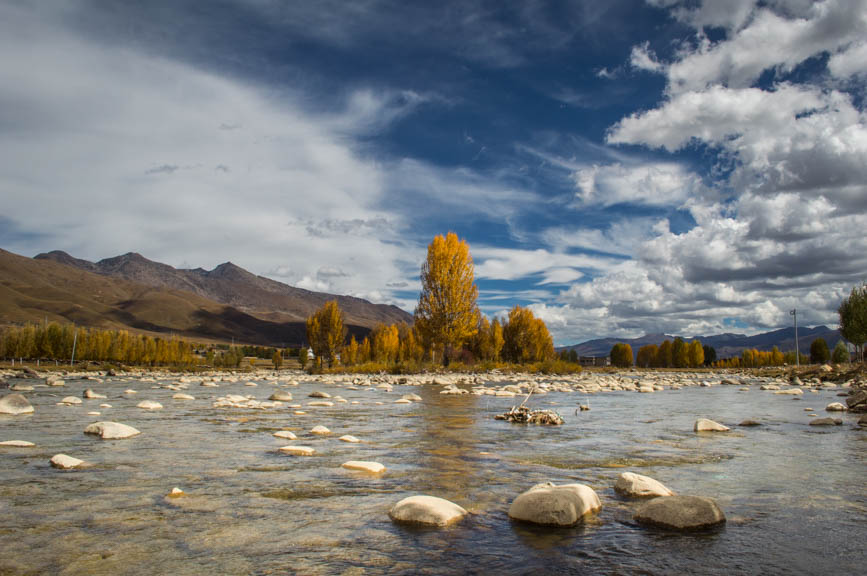
The autumn leaves crackle as they are crushed under the wheels of our bicycles. The rest of them hold onto their tall trees for as long as possible, not willing to let go and fall into their long winter graves. We let out short puffs of breath, cycling the 10 km to the red grasslands outside the town of Doacheng in the region of Tibetan Ganzi.
I remember the road looking flat, but at an altitude of almost 4000m, even the slightest incline seems to get your blood pumping extra fast. A motorcycle approaches and I calm my breath, trying to make it look easy, before gasping for air once they have roared passed. Do you do that to? Seems so silly, but when there is an audience we instinctively hold our breath in, “yes yes we are fine thank you, even though my face is bright red, this is actually a piece of cake” and once we are alone we huff and puff till we feel our lungs again. Maybe it’s just me.
The road into Daocheng from Litang is easily one of the most breathtaking, spectacular, stunning, take your pick, roads we have taken on this trip so far. At 4500m, this preserved area is open and wide. Soft hills are dotted with razor-sharp rocks and in the afternoon glow, it is all tinged copper and rust. The plateaus have no visible end and on its edges are solitary trees, like old paintbrushes caked with thick yellow paint soaring into the sky.
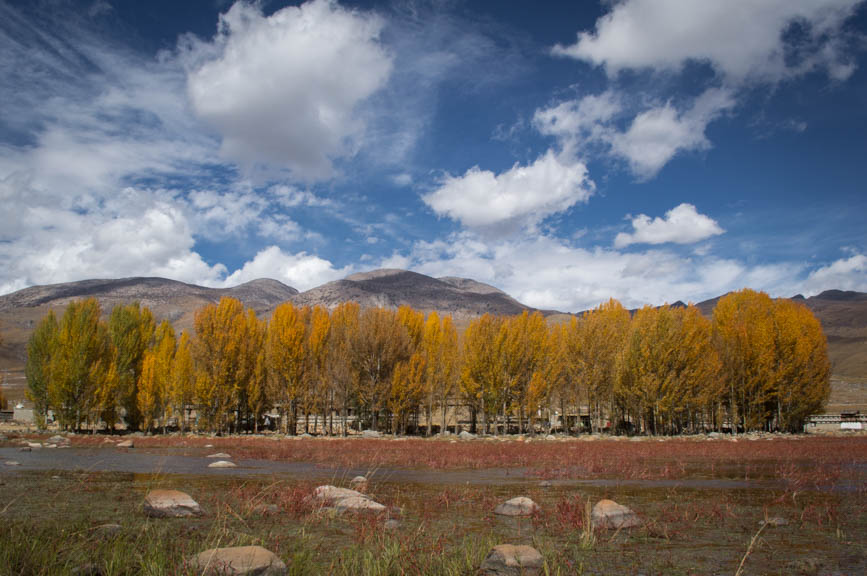
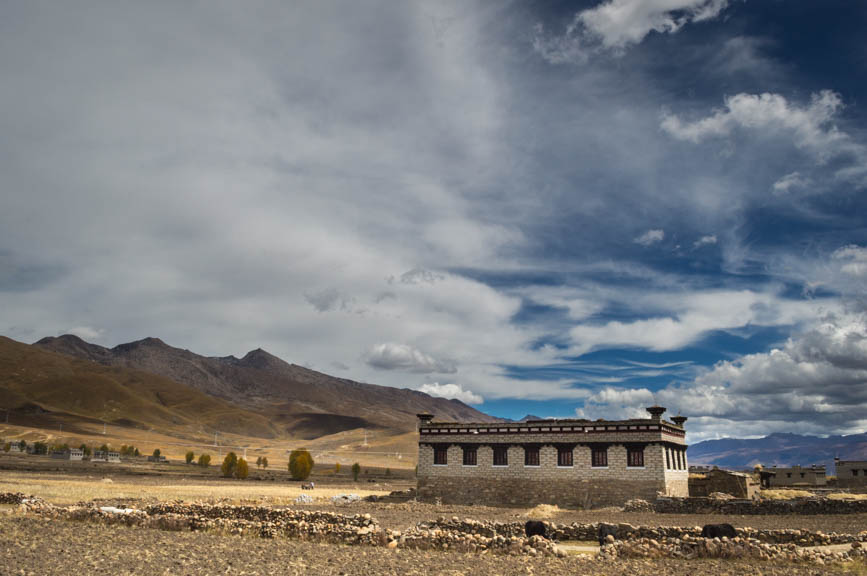
Daocheng itself is nothing to write home about, but a short escape to its outskirts is worth every push of the pedal and so we find ourselves finally hooking our bicycle locks to some kind of haphazard construction amid a few shy goats and a curious dog. The Tibetan village of Jiyi is famous for its red grassland 红草地, a wetland sprouting a species of “water pepper” that accumulates its deep red pigment in autumn and attracts hundreds of tripod-toting tourists in its peak months.
But there is movement behind the wall of amber trees and we decide to investigate that instead. Through the narrow path shaded by orange poplars, there is a network of Tibetan “castles”. Imposing brick structures, two storeys high with multiple windows on each side framed in black wood. The flat roofs are cornered by miniature towers, each house proudly displaying a slightly different design. We spy a group of women carrying woven baskets and trays, their hips swaying gently in line with their laughter and rapid chatter. We follow.
There in one of the “castle” garden’s is a large group, men and women busy sorting grains into large sacks for winter. Shake shake shake, pour and wrap, the cleaned grains fall into the bag making a melody of their own, like the percussion set of a samba band. We hesitate to go closer. There is always a moment when travelling in foreign lands where you decide to interact. Are we disturbing? Are we intruding? Curiosity about the “unknown” drives us to push boundaries, but fear can often hold us back. We decide to go for it, we inch closer saying hello with huge smiles to mask our hesitation and are welcomed with “I love you!” followed by countless giggles. Everyone explodes into laughter and all is well, “hello” and “I love you” are their favourite and perhaps, only english words.
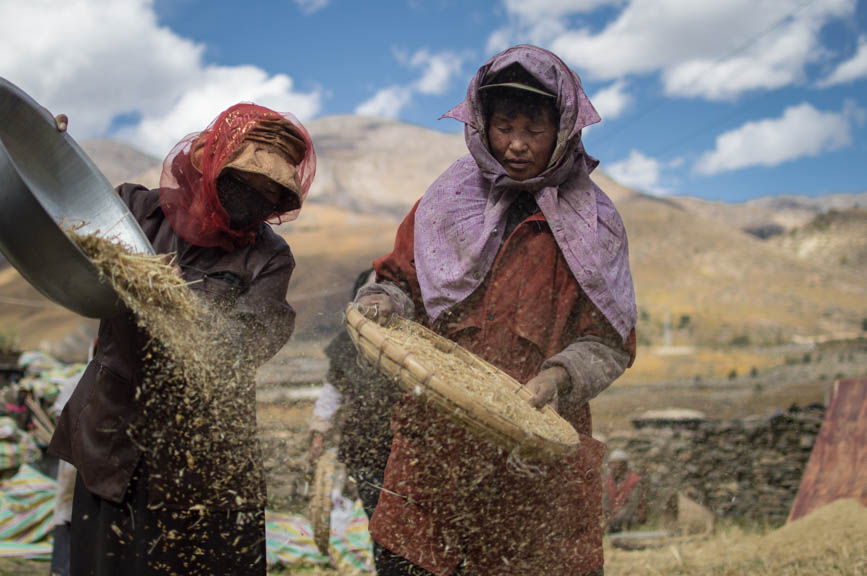
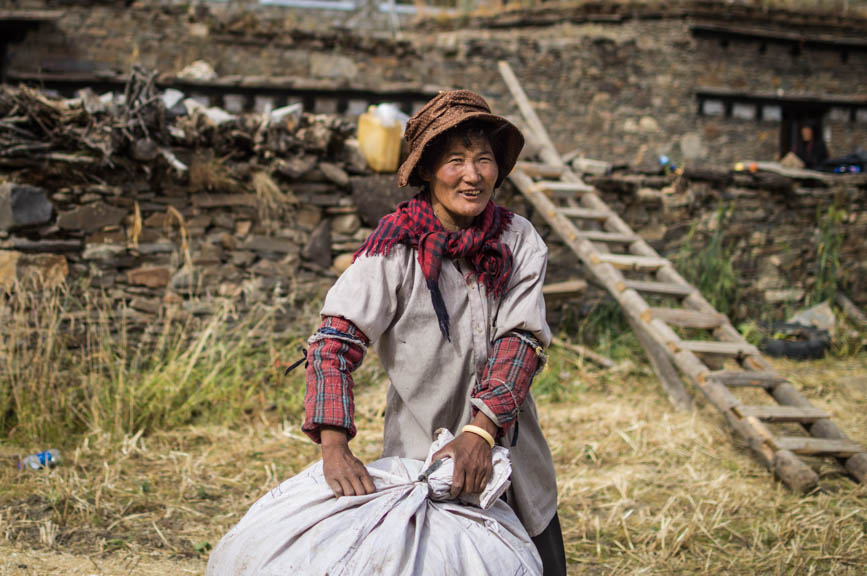
The women have scarves to mask their faces as the dust from the grains fly up in reverse-twisters. I point and ask, “tsampa?” to which everyone nods. This is the barley harvest. The Tibetan diet relies heavily on barley, it is the main ingredient for their favourite tsampa རྩམ་པ . Easily stored to last the freezing dark winters, barley is ground into flour and mixed with butter tea to form a paste, filling and nutritious. In the past, eating tsampa was one of the few elements which applied universally to all Tibetans. There are multiple dialects, different buddhist sects and various regional traditions, but everyone eats tsampa. During the 1959 Tibetan Rebellion, the phrase “tsampa-eater” was employed to promote a single Tibetan identity and while numerous things have evolved since then, tsampa has remained a staple in Tibetan necessities.
The women hold up trays of hay and grains and pause. They are waiting for the wind. Once the breeze blows through, they rattle and rock, the lighter husks and flakes scatter into the air, carried away by the wind, the heavier stalks tumble to the ground, ready to be rolled up and stored for the animals.

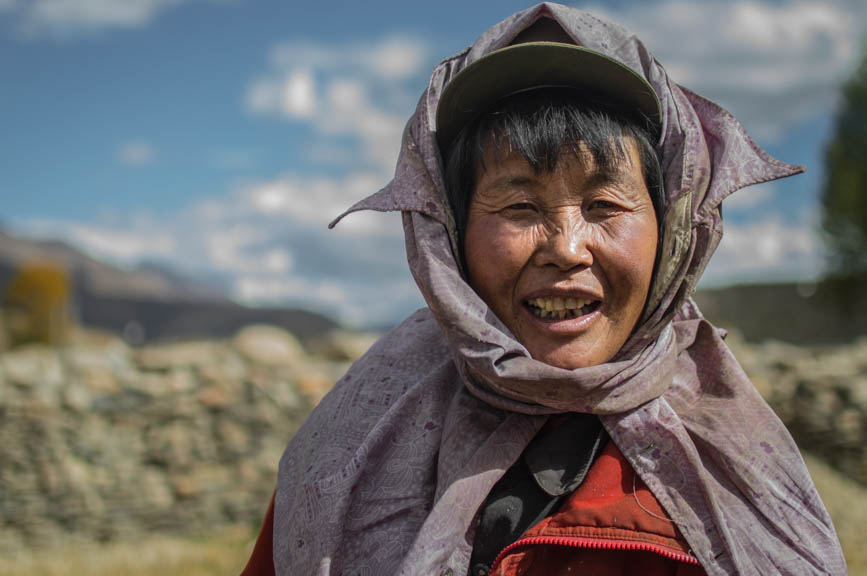
Once the baskets are emptied, there is a frenzy and the largest plastic sheet is brought out, floating like a sail, held up by a legion of hands. On one end, a guy hops and rolls rapidly towards the centre, wrapping the sheet as tightly as possible, ready to be used at the next harvest, at the next “castle”.
Everyone starts moving towards the house and we prepare to leave, until one of them gestures at us, “Mishi mishi di!” We smile and repeat “mishi mishi di!” wondering what it means. We revert to our childhood ways when we do not comprehend, imitating the sounds we hear, hoping to catch some meaning by reproducing the words. He mimes pushing rice into his mouth from a bowl and says, “chi fan” in chinese, meaning eat, it is time for lunch!
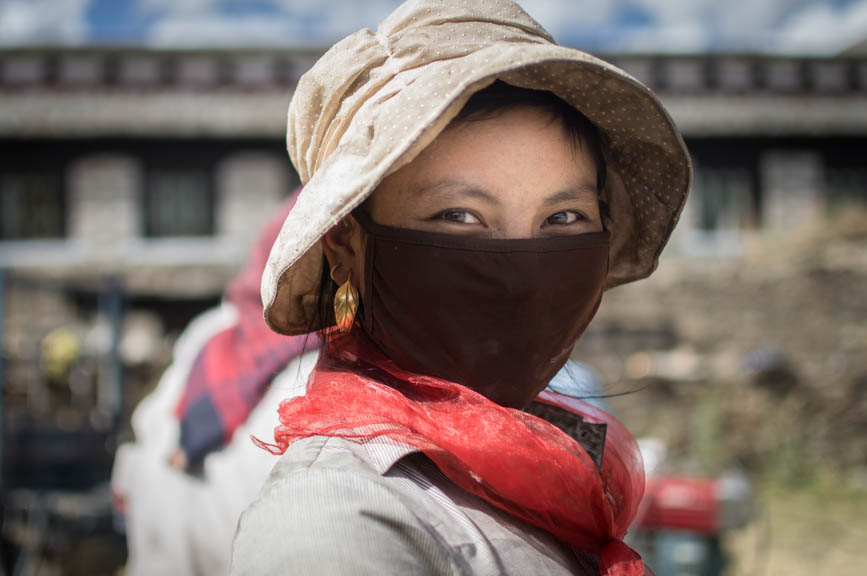
We eagerly accept, excited to be invited into a Tibetan “castle”, finally able to see the interior of these large fortresses. We shuffle in one by one where some women have already been preparing a meal. Eight families have come to help today, so they are all offered lunch in return and tomorrow they will eat and work at another house. The thick wooden doors open up to an extensive ground floor, to the left is the dining room and kitchen, to the right and almost everywhere else is a space resembling a barn. The grand exterior of the “castle” masks the poverty that dwells inside.
A dry haystack towers in the corner, a burgundy motorcycle (the modern Tibetan “horse) leans heavily against it. Various farm gear cast twisted shadows under the wooden stairs leading to the second floor. Our host waves his arm upwards, dark wooden beams protrude from the white ceiling high above the floor, “we are still renovating upstairs.”
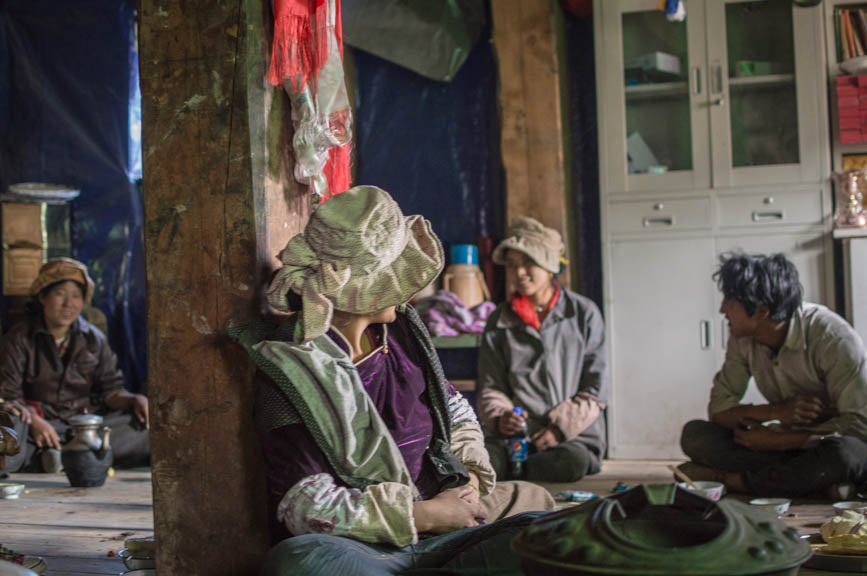
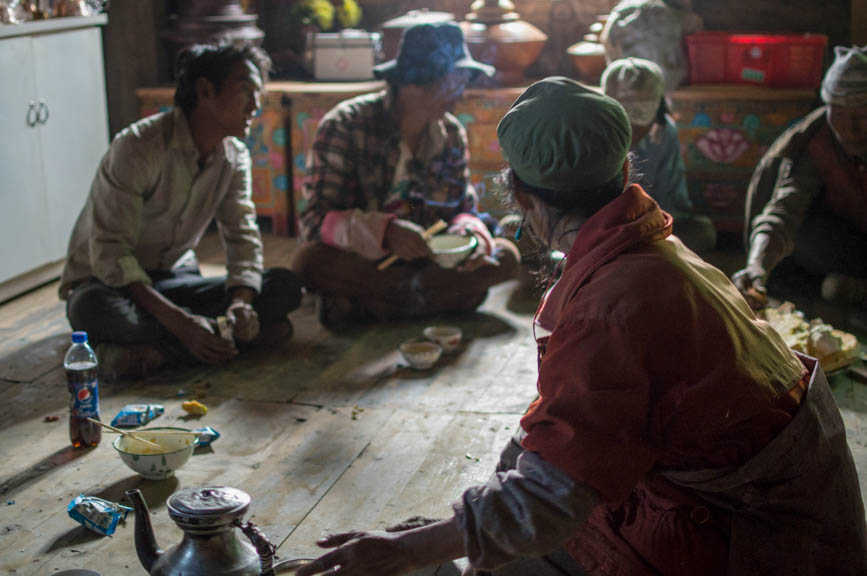
The dining room creaks and croaks as we all enter and sit on the dust-covered timber planks. A green glow is projected by the curtains hanging on the tar-coloured window frames and the hot stove at the centre of the room is smoking white fumes. The women enter with a heavy cast-iron pot, filled with a stew of cabbage, potatoes and some kind of meat and bowls are dished out and handed around. Everyone uses chopsticks and soon the bowls are empty. We are given bowls of steaming butter tea (po cha བོད་ཇ་) a concoction of tea leaves, water, salt and yak butter. We start sipping, but before long our host waves and motions for us to hand him our bowls. Grabbing a plate of barley flour he drops spoonful after spoonful of the powder into our tea and show us how to stir it. Soon my chopsticks can barely move, coated in thick tsampa paste. It is surprisingly tasty, almost nutty and I can’t help but imagine what it would be like with walnuts, brown sugar, yoghurt and maybe even a touch of cognac. A big chunk of crumbly dry yak cheese is offered to us next and I have to admit I prefer the tsampa.
Our initial conversation consists of hand signs and laughter, as our host asks us where we are from, then says “yes, France and Dalai Lama friends,” an enactment of a handshake follows, but China and Dalai Lama not friends, head shakes and the back of each palm comes together to hit each other, like our version of two fists punching the other. We continue in Chinese, our one common tongue and in some ways I am saddened, wishing I had another language to offer.
In less than twenty minutes, the whole affair is over, bellies are full and the men light their cigarettes in unison as the ashes fall. The red-hot butts are spent directly onto the wooden floorboards and everyone shuffles back outside.
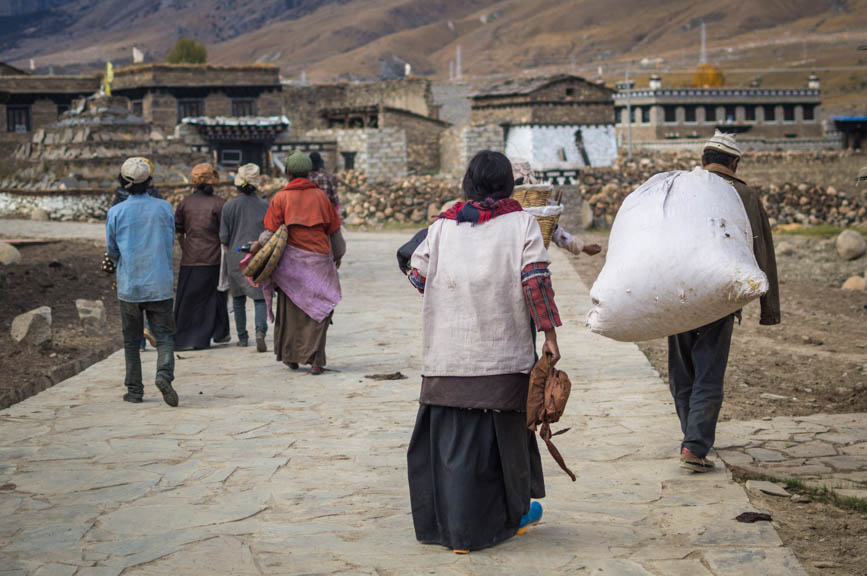
A few “I love you”s later, one by one some mount their motorcycles, others rev up the engine of their tractors and the rest leave on foot, their baskets and woven trays back on their hips. We are touched. Once again, strangers have opened their homes to us, nourished us and taught us something new.
We wave good bye until they are out of sight and back into their castles, happy once again to have followed the unexpected. As we make our way back to our bicycles and tripod-toting tourists just five minutes away, we can’t help but think that if we could wish on a genie’s lamp, we would wish to speak all the languages of the world.







9 Comments
Petit
November 8, 2014Les photos aussi bien que le texte sont extraordinaires!
Quelle expérience vous êtes en train de vivre !..
Je suis subjugué
Bernard
Kristen
November 11, 2014Stunning photos and stunning writing as always. It sounds like an amazing experience. As a naturally shy person, I find it hard to take that next step, but it’s always so worth it when you do.
Language is such a strange thing isn’t it. I couldn’t agree more – being able to communicate would be the number 1 thing I wish for. Assuming my other first wish of everlasting travel had already been granted 🙂 Someone needs to invent the babel fish from the Hitchhikers guide to the galaxy series!
tammy
November 13, 2014Stunning photos as always and a lovely read! So interesting! Wish I can come with you! It’s not easy to go into other peoples house! Well done!
DAniel
November 14, 2014What an amazing experience. And the pics, wow. Note to self: always venture into the unknown behind the wall of amber trees 🙂
Nico & Gabi
December 1, 2014Exactly D! When are we meeting up?
Camilla
November 14, 2014Do you like butter tea more now than before???
Nico & Gabi
December 1, 2014haha definitely a little more…
sv388aduayam.net
August 3, 2023Hi mates, pleasant paragraph and good arguments commented here, I
am really enjoying by these.
leci123
August 4, 2023If you desire to get much from this paragraph then you have to apply these techniques to your won webpage.